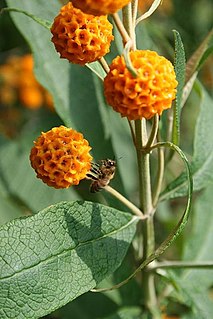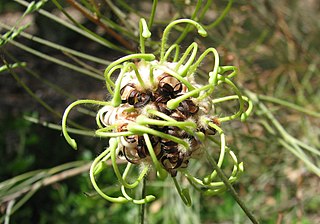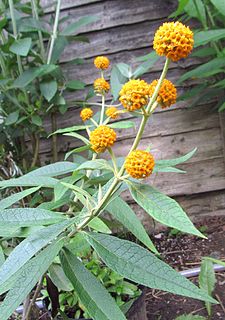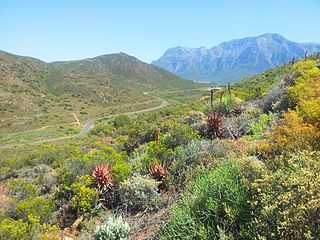
Euphorbia is a very large and diverse genus of flowering plants, commonly called spurge, in the spurge family (Euphorbiaceae). "Euphorbia" is sometimes used in ordinary English to collectively refer to all members of Euphorbiaceae, not just to members of the genus. Some euphorbias are commercially widely available, such as poinsettias at Christmas. Some are commonly cultivated as ornamentals, or collected and highly valued for the aesthetic appearance of their unique floral structures, such as the crown of thorns plant. Euphorbias from the deserts of Southern Africa and Madagascar have evolved physical characteristics and forms similar to cacti of North and South America, so they are often incorrectly referred to as cacti. Some are used as ornamentals in landscaping, because of beautiful or striking overall forms, and drought and heat tolerance.

Buddleja is a genus comprising over 140 species of flowering plants endemic to Asia, Africa, and the Americas. The generic name bestowed by Linnaeus posthumously honoured the Reverend Adam Buddle (1662–1715), an English botanist and rector, at the suggestion of Dr. William Houstoun. Houstoun sent the first plants to become known to science as buddleja to England from the Caribbean about 15 years after Buddle's death.
Magnolia globosa, the globe magnolia or hen magnolia, is a species of Magnolia native to Bhutan, southwestern China, northeastern India, northern Myanmar-Burma, and eastern Nepal.

Endiandra is a genus of approximately 100 species of plants, mainly trees, in the laurel family Lauraceae. They are commonly called "walnut" despite not being related to the Northern Hemisphere walnuts which are in the family Juglandaceae.
Susan Carter Holmes is a botanist and taxonomist at the Royal Botanic Gardens, Kew. She discovered and catalogued more than 200 plants of the family Euphorbiaceae, particularly of the succulent East African members of the genera Euphorbia and Monadenium, as well as about 20 Aloe species. All plants and articles are published under her maiden-name Susan Carter.
The elm cultivar Ulmus 'Globosa' was first described in the Späth nursery catalogue of 1892–93. Considered "probably Ulmus carpinifolia " by Green

Buddleja globosa, also known as the orange-ball-tree, orange ball buddleja, and matico is a species of flowering plant endemic to Chile and Argentina, where it grows in dry and moist forest, from sea level to 2,000 m. The species was first described and named by Hope in 1782

Euphorbia poissonii, also known as Euphorbia poissoni and, incorrectly as Euphorbia poisoni is a highly irritant and toxic succulent member of the large and varied spurge family of plants. It is native to northern Nigeria, where local farmers extract its latex for use as a pesticide. Its powerfully irritant and pain-producing nature mandates use as a fencing plant.

The Euphorbiaceae are a large family, the spurge family, of flowering plants. In common English, they are sometimes called euphorbias, which is also the name of a genus in the family. Most spurges such as Euphorbia paralias are herbs, but some, especially in the tropics, are shrubs or trees, such as Hevea brasiliensis. Some, such as Euphorbia canariensis, are succulent and resemble cacti because of convergent evolution. This family occurs mainly in the tropics, with the majority of the species in the Indo-Malayan region and tropical America a strong second. A large variety occurs in tropical Africa, but they are not as abundant or varied as in the two other tropical regions. However, the Euphorbiaceae also have many species in nontropical areas such as the Mediterranean Basin, the Middle East, South Africa, and the Southern United States.
Phuphania globosa is a species of air-breathing land snail, a terrestrial pulmonate gastropod mollusk in the family Dyakiidae.

Grevillea globosa is a shrub in the family Proteaceae. It is endemic to Western Australia, occurring in the northern wheatbelt.

Drupa morum, common name the purple drupe, is a species of sea snail, a marine gastropod mollusk in the family Muricidae, the murex snails or rock snails.

Euphorbia hirta is a pantropical weed, possibly native to India. It is a hairy herb that grows in open grasslands, roadsides and pathways. It is used in traditional herbal medicine.

Buddleja araucana is endemic to the semi-deserts and steppes of Patagonia, from southern Mendoza to Río Negro and Neuquen provinces in Argentina, and adjacent Chile. The species was first described and named by Philippi in 1873, it was introduced to cultivation by the British gardener and plant collector Harold Comber as a form B. globosa in 1925.
Buddleja 'Salmon Spheres' is a British cultivar raised by Steve Nevard, London, from a cross of Buddleja globosa and Buddleja crispa.

'HCM98017' is a cultivar of Buddleja globosa collected from the wild in Chile and introduced to commerce by Pan-Global Plants, Gloucestershire, UK.

Robertson Karoo is a semi-arid vegetation type, restricted to sections of the Breede River Valley, Western Cape Province, South Africa. It is a subtype of Succulent Karoo and is characterised by the dominance of succulent plant species, and by several endemic plants and animals.
Spintherophyta globosa is a species of leaf beetle found in North America. It is widespread east of the Rocky Mountains, its range spanning from the East Coast west to Colorado and western Texas, and it may also occur in Arizona and Mexico. Its body is globose and colored black to dark brown, while the legs, antennae and mouth-parts are red-orange in color. The species is reported to be polyphagous.












